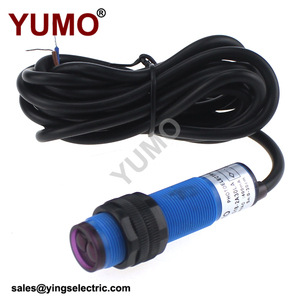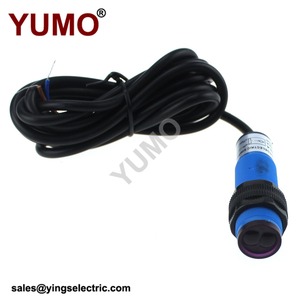(14556 products available)



































































































































































































Passive Infrared Sensors (PIR)
Passive infrared sensors, also known as PIR sensors, are among the most often used types. They can discover motion by identifying changes in the warmth of their surroundings because they are built to be sensitive to the infrared radiation emitted by objects, particularly humans. They are frequently utilized in security systems, automatic lighting, and HVAC systems because they detect motion rather than the infrared itself. For instance, a PIR-equipped security camera will only turn on and record when someone walks into its field of view, conserving energy and extending the camera's lifespan.
Dual Tech Sensors
Adding a second sensing technology, often microwave or ultrasonic, to dual-tech infrared sensors improves on PIR by giving them an extra layer. These sensors lessen the likelihood of false alarms caused by environmental variables like blowing leaves or small animals by combining two detection methods. For example, a security system that uses dual-tech IR sensors will only trigger an alarm if both the infrared and microwave sensors detect movement, adding an extra layer of verification. This quality makes them an excellent option for areas where security is crucial, such as warehouses or restricted areas.
Focal Plane Array (FPA) Sensors
FPAs are sophisticated infrared sensors primarily used in military or surveillance applications. In contrast to traditional infrared sensors, which scan for emitted heat, FPAs can simultaneously detect and form images of multiple points on a thermal gradient. An FPA coupled with a proper lens can detect dozens or hundreds of heat sources simultaneously, enabling users to see a clear thermal image of a scene. These sensors are employed in intense situations because of their exceptional accuracy and broad field of vision, including border security, search and rescue, and scientific investigations.
IS Detecting Sensors
Industrial and commercial applications that need temperature monitoring or leak detection frequently use infrared sensors. These sensors identify temperature variances between objects and areas, enabling them to recognize flaws or leaks that go unseen by the naked eye. For instance, an infrared sensor can monitor the temperature of equipment to discover hotspots that might indicate an issue in a manufacturing facility. These sensors can boost productivity and safety by providing real-time data for maintenance staff.
Water and Dust Resistance
Many infrared sensors, particularly those employed outside, are IP-rated, meaning they can endure dust and water intrusion. The internal components of these sensors are often designed with tightly sealed housings, protective glass or quartz covers over the IR elements, and conformal coating on circuit boards to ward off moisture and particulate damage. For instance, an IR security camera with an IP66 rating can withstand strong rain and dust storms. By providing protection from environmental variables, resistance ratings help keep sensors operational in challenging outdoor situations.
Shock and Vibration Resistance
Numerous infrared sensors are made to survive inconsistent circumstances, including shock and vibration. To guarantee that the sensor continues to function correctly when installed on a moving vehicle or in an industrial setting where heavy machinery produces substantial vibrations, its housing may be strengthened. These sensors frequently undergo military standards testing (such as the MIL-STD-810 test series) to ensure endurance in critical applications. A dual IR sensor used in a construction zone, for instance, may have enhanced shock absorbers to preserve its precise detection capabilities in bumpy circumstances.
High-Temperature Materials
Infrared sensors operate in extreme heat situations, necessitating special materials to endure high temperatures. Metal housings, heat-resistant polymers, and specialized thermal couplings are typical components of these sensors. Great infrared lens sensors used in areas close to furnaces or engines, for instance, are often constructed with silica or other durable materials that can survive scorching temperatures without losing functionality. These components keep the sensor from warping or breaking, which would impair its capacity to detect correctly.
Corrosion-Resistant Materials
To ensure that infrared sensors can endure corrosive environments like chemical plants or coastal regions, corrosion-resistant materials such as stainless steel or specialized coatings for metal surfaces are used. The metal parts of the sensor's body and other exposed areas likely to contact moisture or chemical vapors are made from corrosion-resistant materials. For instance, an infrared thermometer used in a marine application might have a titanium covering to avoid corrosion while still producing accurate readings. In corrosive settings like warehouses or refineries, manufacturers frequently utilize sensor enclosures with polycarbonate to shield the sensitive interior components.
Energy Efficiency Solutions
Businesses can greatly reduce energy expenses by using infrared sensors, especially in lighting and HVAC systems. For instance, a PIR-enabled lighting system will automatically turn off lights when no one is present, conserving energy and prolonging the life of the fixture. In large commercial buildings, infrared occupancy sensors connected to HVAC systems can adjust temperatures depending on occupancy, saving energy by maintaining ideal conditions only when necessary. These energy-saving measures lower operating costs and reduce environmental effect, which is crucial to many firms.
Increased Security
Infrared sensors are essential for increasing commercial property security. Businesses may track suspicious activity even in low-light situations using IR-enabled security cameras. A PIR motion sensor attached to an alarm system can notify personnel of a possible security breach by detecting movement at restricted entrances. Companies may avoid huge losses from theft or vandalism by using this improved security capability. Moreover, continuous security monitoring lowers insurance premiums, providing another financial advantage.
Automation and Labor Savings
Across sectors, infrared sensors support various automation initiatives, increasing efficiency and cutting labor costs. Retail shops, for instance, employ automatic doors with IR beam sensors that open smoothly for clients. In industrial sites, automatic checkpoints with IR temperature sensors may quickly scan workers for safety reasons. These applications save time and labor costs and improve the client experience in retail and workplace safety in manufacturing.
Thermal Imaging in Diverse Fields
Thermal imaging cameras fitted with infrared sensors are useful in many industries, including construction, healthcare, and emergency response. For example, building inspectors can use thermal imaging to find insulation faults or moisture damage without creating any damage. In medicine, thermal imaging can assist in non-contact examinations by detecting fevers or blood flow issues. Environmental and emergency response crews might locate missing persons or monitor wildfire activity with thermal imaging cameras. These tools are crucial for accuracy, speed, and safety in these sectors, leading to lower expenses and better results.
Assess Application Requirements
Knowing why an infrared sensor is needed is essential. While some uses may need close range, like automatic doors in retail, others could require considerable distance, like surveillance or thermal imaging. Furthermore, while some settings might still allow for manual control, a production floor that requires constant monitoring for temperature variations might demand an IR sensor with an output that can interface directly with other industrial gear. One can guarantee that the selected sensor fulfills the primary functionality for which it is intended by completely understanding the application requirements.
Evaluate Environmental Conditions
The operating atmosphere significantly impacts the infrared sensor type selected. Outside or in a place with variable weather, the sensor enclosure should have strong weather resistance, like an IP rating. In such situations, anti-dust and anti-water features are required for effective performance. Shock and vibration resistance may be essential for applications involving moving vehicles or machine floors. Heat and chemical resistance are critical considerations if the sensor operates near furnaces or in chemical plants. Long-term dependability ensures that the sensor will continue to function correctly despite environmental hardships.
Review Sensitivity and Range Specifications
Thermal imaging or motion detection may need high sensitivity from different applications for optimal performance. It is critical to evaluate the sensor's field of view (FOV), which indicates how much area it can observe, and its detection range, which shows how far it can recognize objects. Pir home, for example, is ideal for interior motion detection since it has a short range and a wide field of view. A thermal imaging camera with a longer range and greater sensitivity would be more suited for security or search-and-rescue applications.
Consider Integrated Technologies
Modern infrared sensors frequently employ other technologies to enhance performance. Dual-tech motion sensors, for example, employ both microwave and infrared to increase accuracy by adding another motion detection method. Some thermal cameras incorporate picture processing software to analyze the data for various uses, including energy audits or medical examinations. One can benefit from the sensor's full capability and ensure that it satisfies specialized requirements by considering the extra technologies integrated into the infrared sensor.
Infrared sensors work by locating and measuring the infrared radiation emitted from bodies, surfaces, and environments. They can identify temperature variations and generate an image or signal from those variations because all objects radiate some infrared energy. The radiation emitted increases as an object becomes warmer, making the IR sensor able to detect it. This technique is the foundation of applications like thermal imaging and temperature monitoring, enabling the sensors to provide data based on the heat signature of things in their line of sight.
Automatic lighting, security monitoring, temperature checking, and imaging are just a few functions of infrared sensors. In security, for example, an IR sensor can observe motion in low-light circumstances, informing an alarm system. IR thermometers can take quick temperature measurements without touching the object in healthcare and industrial situations. Moreover, thermal imaging may locate missing persons or check building insulation in emergency response and fire fighting. These sensors provide operational efficiency across various sectors by enabling automation and real-time monitoring.
While particularly efficient in low-light situations, infrared sensors are not meant to detect motion through glass. Since the IR radiation will reflect off the glass rather than pass through it, most IR sensors, including PIR, cannot identify motion through glass. However, some IR security cameras, especially those designed for outdoor use, may capture activity through a glass surface. Various manufacturers of infrared devices provide unique solutions to that problem, such as mounting IR sensors outside a window, which might act as a barrier between the IR elements and the glass.
Yes, many infrared sensors are made for outdoor use and come with weatherproof casings, IP ratings, and other features like UV resistance. Because outside circumstances can be erratic, durability, resistance to dust, moisture, and extreme temperature, as well as additional features like anti-vibration or shock resistance, are often required. For temperature monitoring, outdoor IR sensors are frequently employed in weather stations, building management systems, and industrial plants and for perimeter security, motion detection, and wildlife observation.